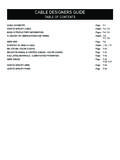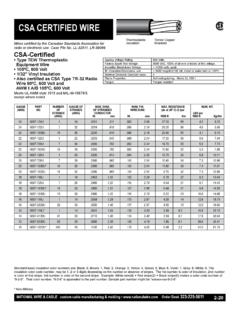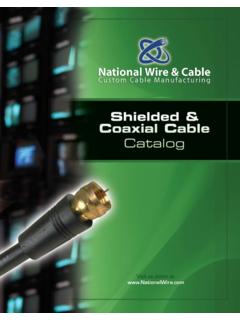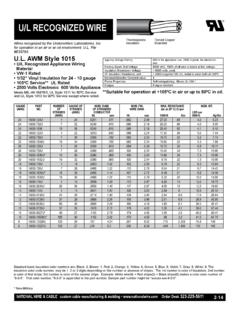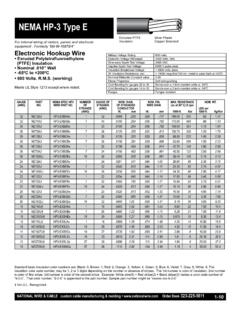Transcription of CABLE DESIGNERS GUIDE - National Wire
1 CABLE DESIGNERS GUIDE . TABLE OF CONTENTS. CABLE GEOMETRY Page 7-1. HOW TO SPECIFY CABLE Pages 7-2, 7-3. BASIC INTRODUCTORY INFORMATION Pages 7-4, 7-5. GLOSSARY OF ABBREVIATIONS AND TERMS Pages 7-6, 7-7, 7-8. WIRE AWG Page 7-9. SYNOPSIS OF WIRE & CABLE Pages 7-10, 7-11. MIL-STD-681 COLOR CODING Page 7-12. MINIATURE SIGNAL & CONTROL CABLES - COLOR CODING Page 7-13. INSULATING MATERIALS - COMPARATIVE PROPERTIES Page 7-14. WIRE TABLES Page 7-15, 7-16, 7-17. HOW TO SPECIFY WIRE Page 7-18. HOW TO SPECIFY PAIRS Page 7-19. CABLE DESIGNERS GUIDE . CABLE GEOMETRY. Design Geometry of Multi-Conductor Cables C. Filling Interstices To those outside of the industry, the geometric design principles used When a CABLE contains a wide mixture of wire diameters, the larger in CABLE -making may not be apparent. To assist the customer in compre- wire sizes or subcables may be CABLE -formed so as to deliberately leave hensively discussing his needs with our factory engineering staff, we offer a interstices large enough for the smaller wires to lie within tangent to two brief GUIDE to the major design options and tradeoffs available.
2 A DESIGNERS adjacent large wires, but not in contact with the inner layer or core. check list for specifying CABLE is offered elsewhere in this section. Not all are aware that for a given number of wires, several different geometry's may D. Use of Fillers be used to form the wires into a helical CABLE bundle. Any of them may be Where a layer requires more wires than are available to properly fill all justified, depending on cost, intended use and performance, or limitations positions in that layer, round fillers are used to occupy the otherwise vacant of the manufacturers' equipment. National Wire & CABLE Corp. has perhaps sites. Their use ensures a round shape and provides adequate support for the widest and most versatile selection of modern CABLE -making equipment the outer layers of the construction. These may be spare wires, or of plastic in the custom CABLE industry. We welcome your knotty design problems.
3 Our rod, jute, or twisted yarns or tapes. They are often used as a core member, 40 years of experience in wire & CABLE field are at your disposal. and may be deliberately designed into a layer to permit circumferential com- pression in a layer during flexing of the CABLE . Conductor Layup Geometry Options CABLE Flexibility A. Layer Upon layer When a helically cabled bundle is flexed, each of the wires in a layer When all conductors have equal diameters they can be cabled in tend to slide along their helical path slightly with respect to the wires ad- simple layers around a suitable core or central wire. Theoretically, every jacent. If the wires are in firm contact around the entire layer, the friction layer will contain 6 more wires than the preceding inner layer. This can be between them inhibits the desired sliding action, and additional stiffness is shown with a few round disks or coins. In practice this is not always true.
4 Imparted to the CABLE . Interlayer friction can also contribute to CABLE stiff- Tolerances of insulation diameters enter the picture. Further, the conduc- ness. In general, any stored radial forces which contribute to the friction tors spiral in a helical path when formed into CABLE , and thus occupy an should be avoided by proper design and manufacturing techniques. These elliptically-shaped area around the circumference of the core. Typically, the forces may be from unduly snug jackets, braids, wraps, or serves. eccentricity of the ellipse is about 5%. Thus about 19 conductors may fit, where 20 should if they were assumed to occupy a circular cross-section. CABLE Flexibility Design Assistance B. Subcabeling Due to the many variable factors which influence CABLE designs, we For some constructions small groups of wires are helically cabled into strongly recommend that the customer consult with our technical staff to subcables, which are then helically cabled to form the finished bundle.
5 They ensure proper choice of dimensions and tolerances when he generates his may take these forms due to the end use requirements, ( : where the own specification. design calls for twisted pairs, trios, etc.) or may do so mainly for the conve- For design reference, a few of the common geometry's for subcabled nience of the lay-up of the required number of wires in an available site with- and intersticed constructions are shown. The diameter of the large mem- in the CABLE cross-section. Advantages of this method are improved flexibil- bers is taken to be one unit of diameter. The size of the other members are ity of the CABLE , possible convenience in the intended end-use for the CABLE shown as some decimal which relates their size to that of the large member. and the wide selection of geometry's it offers the designer . Disadvantages For layer-on-layer constructions, the table shows the factor by which the compared to the layer-on layer method are usually increased diameter and wire diameter can be multiplied to obtain the cabled bundle diameter.
6 Cost. Where there are hundreds of conductors in a CABLE , this method is often used to permit cabling on relatively small cabling machines..31 POSSIBLE CABLE CONFIGURATIONS & RELATIVE DIMENSIONS..13 .36 .34..13..66 .47 .4. 1. 1. 1. 1. 1..23 1. 1. 1. 1. 1..4 .4 .4 .7..47 .47 1. 1. 1. 1. 1. 1..25 1. 1..23 .4 1. 1. 1. PAIR TRIO QUAD QUINT 6 AROUND 1. DIAMETER OF HELICALLY CABLED BUNDLES*. TO FIND THE CABLED DIAMETER OF A LAYER-ON-LAYER CONSTRUCTION, MULTIPLY THE DIAMETER OF A WIRE BY THE FACTOR SHOWN.**. No. of Diameter No. of Diameter Number of Diameter Number of Diameter Conductors Factor Conductors Factor Conductors Factor Conductors Factor - - 13-14 34-37 64-67 2 15-16 38-39 68-73 3 17-19 40-42 74 4 20 43-47 75-78 * All conductors are the same diameter 5 21-22 48 79-83 ** (these factors are typical for standard 6-7 23-26 49-51 84-89 helical cabling prectices; slight variations 8 27 52-55 90-93 may occur on certain combinations) 9-11 28-30 56-60 94-98 12 31-33 61-63 99-105 7-1 National WIRE & CABLE custom CABLE manufacturing & molding Order Desk 323-225-5611.
7 CABLE DESIGNERS GUIDE . HOW TO SPECIFY CABLE . Custom CABLE Design GUIDE If you plan to specify a special CABLE , we highly recommend a call to our user Friendly technical staff who can help speed you over the bumps. a bb a c a c d e, f g, h, i, j k In the absence of your own CABLE specification, the following checklist will assist you to completely specify the CABLE you want: A. Number and gauge of conductors. B. Specification type of wire (military or commercial). C. Coding of conductors or subcables, striping or numbering, if any. D. Tape barrier, used as first mechanical protective layer. Can be of Vinyl, Mylar, Tedlar, Polyethylene, or paper-fiberglass laminates. E. Type of electrical shielding or mechanical armor. F. % coverage required for electrical shielding G. Type of outer jacket material. H. Color of outer jacket, sheath markings. I. Wall thickness of outer jacket. J. Necessary physical or environmental requirements, see below.
8 K. Minimum and maximum overall diameter. Physical Requirements 1. Length, tolerance; Diameter, tolerance. 2. Overall tensile strength, if applicable. 3. Weight limitations. 4. Minimum bend radius. Environmental Requirements 1. Minimum and maximum operating temperatures. 2. Physical abuse: terrain, degree of movement of flexing, possible sudden impacts or pressures, etc. 3. Surrounding medium: water , oil, sunlight, ice, fuels, air, etc. Electrical Requirements 1. Voltage rating of the conductor insulation. 2. Maximum current expected in the conductors. 3. Amount of electrical or magnetic shielding required. 4. Capacitance requirements. National WIRE & CABLE custom CABLE manufacturing & molding Order Desk 323-225-5611 7-2. CABLE DESIGNERS GUIDE . HOW TO SPECIFY CABLE . Insulated Conductors 2. Braided RFI shields Specify quantity, gauge, stranding and insulation type for the conduc- The most common and perhaps the most durable CABLE shield is a tors.
9 Allowance of 10% spares is a common practice. braided tubular shield made of small copper wires. Wire sizes range from #38 to #32 AWG. A braid is the standard coaxial CABLE outer conductor. It Preferably suggest an agency specification for the wires. ( : UL, may be applied in one or more layers. In conjunction with metallic tape CSA, MIL and their proper type or style no.) or foils, performance becomes very good. Braiding is a continuous opera- tion, any desired length can be made. A braid is machine-formed directly You may need a MIL reference to preferred wire types and jacket ma- onto the CABLE as contra-helical interlocking spirals of groups of fine wires. terials in various applications and environments. The effectiveness of the shield braid depends on how well it covers up the surface of the CABLE . A minimum coverage requirement of 90% of the Fillers CABLE surface is common. Machinery limitations make coverage in excess Fillers are used in lieu of a wire to fill space in a CABLE bundle so that of 96% impractical for a single-layer braid.
10 For braids that must push-back . it can retain its controlled shape and geometry. Their use promotes round- or swell easily, the braid angle should be specified. We recommend angles ness and uniform flexibility. between 20 and 38 degrees for that service. Various methods of shielding can be combined for optimum RFI protection. See Shielding Effectiveness . Preferable fillers are plastic rods, tapes, or fibers, having physical elsewhere in this section. properties similar to those of the wire insulation. Round glass-fiber braid can be used for high temperature applications. Fibrillated polypropylene is commonly used; cotton or jute is used less frequently. Outer Jacket/Sheath The choice of outer CABLE covering material is usually a compromise Cables (within the main CABLE ) between cost, agency recognition/ratings, flexibility and durability. Individually cabled groups of wires within the CABLE may be referred to as sub-cables.
